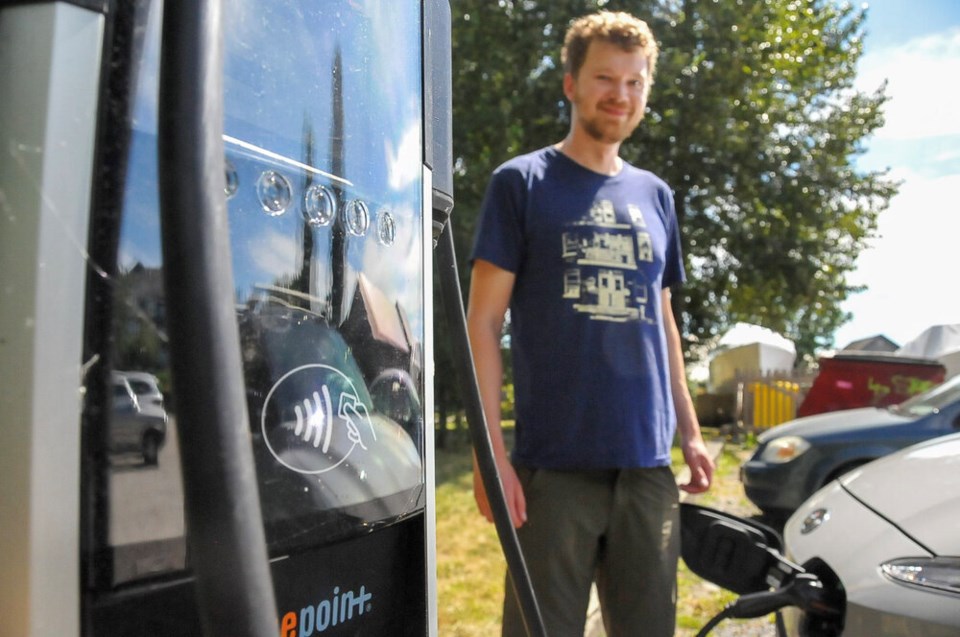Upwards of 100,000 new public charging stations need to be built across Metro Vancouver over the coming decades in order to keep up with electric vehicle demand, a new report has found.
The report, presented to Metro Vancouver’s Climate Action Committee Thursday, offered councillors and mayors across the region a first look at the scale of new infrastructure required to shift transportation away from fossil fuels.
Lisa Dominato, chair of Metro’s climate action committee and a Vancouver city councillor, said the number was so astonishing, she read the report twice before Thursday’s committee meeting.
“Mind-boggling,” Dominato said. “And then I looked at the the costs associated with it — in the billions is what they're projecting.”
Light-duty vehicles, which include cars, light trucks and SUVs, currently account for a third of all Metro Vancouver’s greenhouse gas emissions, making them the largest source of the region’s carbon pollution.
Electric vehicle sales are slowly cutting into those emissions. EVs currently make up only five per cent of vehicles in Metro Vancouver, but in 2022, they accounted for 20 per cent of all new vehicle sales. That makes it the region with the highest electric vehicle adoption rate in all of Canada.
Over the coming years, those sales are only expected to grow. All new light-duty vehicle sales in B.C. are legislated to be zero-emission by 2035. By 2038, the number of electric cars on the road is expected to grow to one million, an 11-fold increase over 15 years. Roughly a decade later, the region's entire vehicle fleet will be run on electric or some other zero-emitting technology, according to provincial targets.
Governments failing to match up to $2.9-billion price tag
To meet the electric charging demand, the public and private sector will need to build between 4,600 to 7,700 public direct current fast charging ports and 54,700 to 97,600 public Level 2 ports. Those include chargers on the side of a highway, on the curb, and in workplace or public parking lots. Wherever they are built, the Metro report emphasized chargers need to be built where people already park.
All of it will cost an enormous sum of money. Together with retrofitting the parking garages of old multi-family buildings, the build out of new public chargers is expected to cost between $2.1 billion and $2.9 billion by 2050.
“I don't think we've really absorbed the size of the problem yet,” said Patrick Johnstone, vice-chair of the committee and mayor of New Westminster. “Someone's gonna have to show up with the money to support that.”
So far, the report says the amount of money the B.C. and federal governments put forward has been “insufficient to meet growing demand.” Not building enough EV charging infrastructure “could even threaten the viability” of the government's entire electrification plan, the report warns.
“I don't think people realize the need. I think this is the first report that's really put the need out to us in a in a measurable way,”Johnstone said.
Home charging important, but most still use public chargers
Charging at home will play the largest role to support the electric vehicle transition, notes the report. A 2022 BC Hydro survey found 86 per cent of EV drivers charged their cars at home. But a similar portion said they also used public chargers.
The expansion of public charging infrastructure remains critical to encourage drivers to switch to electric vehicles, especially for “garage orphans” who don’t have access to private home parking, and people in multi-family buildings that have yet to be retrofitted with chargers, the Metro report said.
“Charging in locations outside the home, such as in the workplace, in the public realm, and at privately owned retail locations will be the only choice for residents who do not have access to home charging, making public charging a critical part of the regional EV charging system,” said the report.
Public chargers are also expected to play a growing role to help drivers charge during the day. As more low-cost solar energy comes online, such charging is expected to help reduce peak loads on the electric grid.
“Where possible, Metro Vancouver and its members should maximize the potential of EV charging at drivers’ homes, workplaces and regular destinations, as opposed to new dedicated public charging locations where drivers must make special trips,” the report said.
All sectors required to build out charging infrastructure
Municipalities are expected play a critical role in advancing charging infrastructure through investment, streamlined regulations, offering land to install the chargers, setting targets and acting as a nexus to educate everyone from the public to developers, landowners and investors.
The plan calls for cities and regional bodies to simultaneously prioritize active and shared transportation alternatives, such as car share programs, public transport and bicycle infrastructure.
BC Hydro plans to play a big role by expanding its charging ports by 3,200 over the next 10 years. But that plan, which includes a proposal to slowly increase charging fees, is currently before the BC Utilities Commission and its outcome remains uncertain.
Whatever comes next, Johnstone said he hopes the report pushes government and the private sector to act quickly.
“Right now, people aren't buying EVs because we can't supply enough EVs. And if that shifts to the point where people don't want to purchase them because they're not reliable [due to a lack of chargers], then that's that's going to be another conversation altogether,” he said.
“We have some time, but we have some work to do.”





